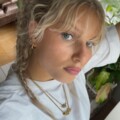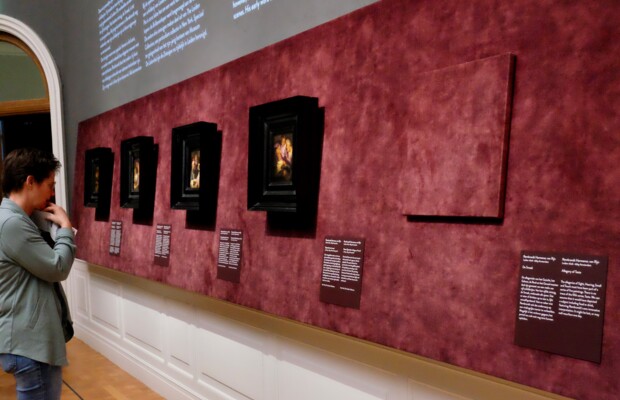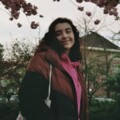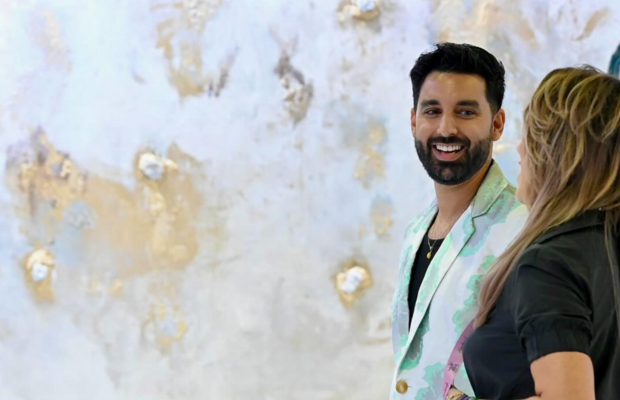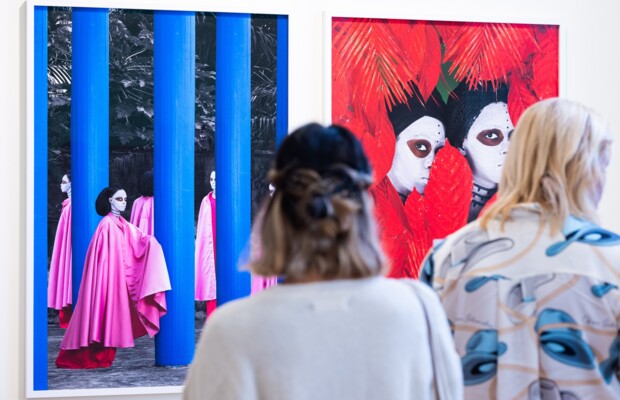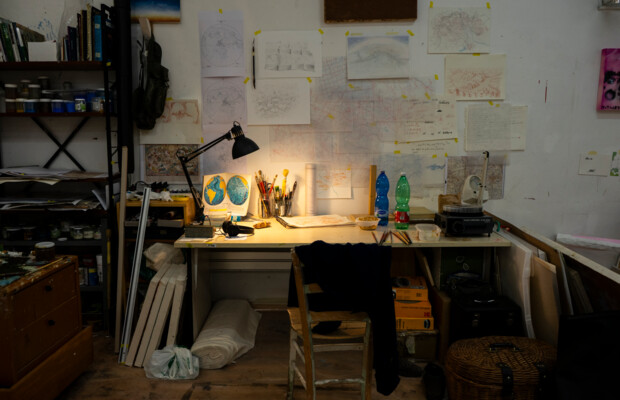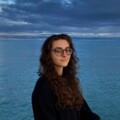Castlemania and fairytales of inclusion and exclusion: a conversation with Jan Hoek
'Castlemania', co-curated with Simon Marsiglia, 'Burn Them All!' and 'Less is Bore' at No Limits! Art Castle on view until June 23. 'Open the Gates!' at Galerie Fleur & Wouter on view until May 12.

Despite not officially having opened for the day yet, the peach-coloured building at Noordwal 1, on the side of the IJ canal in Amsterdam, seems full of life as countless people come and go through the entrance. I’m here to speak with Jan Hoek, the founder of No Limits! Art Castle, about their current exhibition, Castlemania, and its unique set-up and unexpected combination of themes. Consisting of three chapters across two locations, it touches on the Middle Ages and inclusivity.
I choose to wait outside, but the windy April weather in Amsterdam gets the best of me, so I nod when a kind man asks if I’m going inside. Soon after, Jan arrives, and to his surprise, I open the door for him. One might initially be intimidated by his great sense of style: he is wearing a fashionably faded khaki denim set, a black bomber jacket, a black hat and black chunky shoes. However, his presence is very attentive, calm, and confident, and I can sense his admirable ability to make anyone feel seen and safe throughout our entire interaction.

We descend the staircase to the ground floor of the three-storey building as Jan tells me about the diverse creative and cultural organisations that gather here at SEXYland World. For example, an authentic Chinese restaurant, Order Sichuan, operates on the second floor. He also describes a sports club aimed at young Moroccan boys, which gathers to do homework and watch football, to illustrate the different events happening on the backstage area of the third floor. The ground floor acts as a space for club nights, with different hosts each night. In the terrace area, accessible through the back door of the ground floor, lies a black, castle-shaped building: home to the art gallery of No Limits! Art Castle.
The rear of the gallery hosts ‘Burn Them All!’ by Jordan R̶o̶g̶e̶r, the first of three parts in a collaborative exhibition with Galerie Fleur & Wouter. R̶o̶g̶e̶r’s work is steered by anger towards the idea that conforming to heteropatriarchal norms is a prerequisite for living happily ever after. The Paris-born artist intentionally crosses out his last name due to his Jehovah’s Witness parents' disapproval of his gay identity.

I’m amazed by the intricate detailing of the huge, pastel-coloured, burning castle constructed from approximately a hundred ceramic elements. Its beauty, nevertheless, is an illusion: the castle symbolises the lies we’ve been told by Disney fairy tales. The artist’s critique of the Disney universe is rooted in the gender stereotypes present in the cartoons many of us grew up with. Surrounding the burning castle, brightly coloured embroidered pennants hang on the gallery’s walls. Within them, flying, fire-shooting, fairy-like characters can be seen joining the fight to dismantle historically exclusionary, discriminatory and oppressive societal narratives about marginalised groups, such as the LGBTQIA+ community. I can’t help but smile to myself as I imagine joining the fairies’ celebration after burning down oppressive systems with the castle.
Standing in the middle of Johan Vanderschelden’s exhibition in the next room, a strong connection to my inner child awakens. Surrounded by the artist’s eclectic works, I’m moved by a memory of the joy I found in using my imagination and regularly creating art ‘just because’. Vanderschelden was a Belgian art collector, whose legacy is celebrated in the posthumous exhibition ‘Less is Bore’. His universe, filled with knights and castles, consists of various types of artworks, such as clothing that he had upholstered at his studio in De Zandberg during a year-long collaboration with mixed media storyteller Klaas de Baere.

Vanderschelden’s relentless passion to create art radiating through ‘Less is Bore’ is inspiring. Although de Baere described their approach as “production to the max”, the exhibition could also be seen as a rebellion against the capitalist and elitist norms that imply creating art is only valuable if the results, and the artist, conform to elite standards of the art world or generate significant profit. It dares us to expand the art worlds’ traditionally limiting expectations of art and artists, and embrace the pleasure and connection that creating art fosters.
The last chapter of Castlemania, Open the Gates!, is a group exhibition at Galerie Fleur & Wouter. It focuses on modern themes and envisions castles of the future using mediaeval motifs. Overall, Castlemania invites us to question existing power structures and discrimination in the (art) world, and to imagine new narratives that allow for more inclusivity and happiness.
After visiting the first two parts of the exhibition, I sat down with Jan to ask more questions about his career, inclusivity in the art world, and the making of Castlemania.

Lotta: I'm very glad to have the opportunity to speak with you today! Could you tell me a bit about who you are and what you do?
Jan: Yes, my name is Jan Hoek, and I'm the founder of No limits! Art Castle. I still work a little bit as an artist myself, but not so much anymore. I'm also a caregiver, for example to Bruin, a boy who has an extra chromosome. I’ve taken care of him since he was a baby, always babysitting. After a while, I went to art school. Bruin also wanted to be an artist, but he ended up in an atelier run by a care organisation and was very unhappy there because many things he wanted to do, they told him weren’t allowed or possible.
I then brought him to my studio to see what was possible. I also noticed that in the old places where he worked, there were a lot of very talented colleagues. Sometimes in this care setting, they get good care, but it can be difficult for their artistic ambitions to become reality.
I saw that this world and the regular art world was so separate. So, we started the foundation, and now we host exhibitions. Our main goal is to bring together different artist groups that are now separated, with a focus on what used to be called outsider art and regular art. We don't use the word outsider art anymore, only sometimes to explain why we don't use it. We prefer terms like ‘crip artists’ or ‘neurodiverse artists'. I think there are many new words we can use now.
This place is called No Limits! Art Castle, it’s shaped like a castle, and we’ve existed for three years. We do exhibitions here, but also in other places - institutions and museums, from Amsterdam to other places in the Netherlands, and also in Belgium and Mexico. Yeah, so we do a lot.
L: That's amazing! For people who are not familiar with curatorial practice, or being a creative director, could you expand on that role in the art ecosystem?
J: I’m not entirely sure what it means in the art ecosystem, but I can explain what it means to me.
At No Limits! Art Castle we really try to figure things out according to our own rules. Here, a creative director is something between a director and a curator. It means that you define what an art institute stands for, and you either hire curators or curate exhibitions yourself. In our case, it also means connecting artists from the different art worlds, which is a big part of what I do.
It also has to do with the whole look and feel of the art space, what you stand for, and who is in your organisation. For example,
as an organisation we try to maintain diversity at every level, not just in terms of neurodiversity, but also in terms of background and gender representation, from the board to the hosting staff. We always try to have very different people in one room.
L: Where do you make connections with artists, and how do you choose who to exhibit here?
J: We really believe that artists with a care need, disabilities, or who identify as crip or neurodiverse, should be held to the same artistic excellence. So, we really select on quality. But, of course that is quite subjective.
We work a lot with ateliers that support more neurodiverse artists or crip artists. There, we look around to see which artist is ready for the next step or interested in collaborating with others. Sometimes when an artist’s solo work is very good, we show them independently, like now. We try to look everywhere a little bit.

L: And what inspires you?
J: I think what I told about Bruin was the main spark.
I’ve always had this feeling that there are so many people who create, not because they want to climb the stairs of the semi-capitalistic art system and to show their work in a wide Guggenheim space in New York.
When I was much younger, I already felt fascinated when I saw homeless people who lived in a box, but they had made the inside of the box beautiful with everything they could find. And when I see that, somehow my heart beats a little bit faster – because there is the feeling of “Wow, you really do it for yourself”. You really do it out of improvisation and that's what I really, really like.
L: Yeah, not just for the commerciality. That's really sweet because art connects everyone and not just the fine artists or those who have been to art school. That's what makes us human. Some people even say that's what differentiates us from animals, just that we want to make art.
J: Yeah!
L: Have you received education in the arts and how does that shape what you do?
J: I went to Rietveld Academie, which is the main art school in Amsterdam. On one hand, I think it was very nice because Rietveld really works in a way that when you make a wild plan, you learn how to make it true.
But on the other hand, you also get a lot of unwritten art rules in your system about what is good art, what is bad art, how you should present it, and when something becomes valuable. As a result, you also tend to become a part of a little art bubble outside the rest of society. So, I felt that I learned a lot, but I also had to unlearn quite some things when I left Rietveld.
L: How did the collaboration with Galerie Fleur & Wouter for Castlemania come about?
J: We’ve worked with them almost since the beginning. First, we did a fashion festival where we connected artists within the creative industry with artists outside of it. I think Galerie Fleur & Wounter just read about it and thought: “oh, this is so cool, can we collaborate on that?” Then, we had that festival and they became one of the locations. I’ve also worked with them as an artist myself. They are just really nice; I go to their openings a lot and they have a very nice space.
The displaying plan came from Simon Marsiglia, the co-curator. Simon gave me the idea and we figured out that it's actually too big just for No Limits! Art Castle, so we thought it would be nice to have Fleur & Wouter involved.
L: Yeah, the collaboration makes sense because your values match really well.
I think they're also something that's very rare: people who run a gallery and have a heart at the same time. That's something I don't see much in the gallery world. These are gallery owners who bring all their artists self-made kimchi around Christmas, with their bike.
L: Aw, that's sweet!
J: Yeah! So I think that this feeling of taking care of others is also really in their system.
L: Yeah. Do you mean not just...
J: Selling, selling, selling, selling!
L: What audience would you say Castlemania is directed towards?
J: I think it’s quite wide. In general with this place we have quite a young public.There’s a mix of Gen Z, party people and art academy students, but at the same time we also reach an older art public. So, people you see in museums and people from the cultural field. And we also attract people from the care world and neurodiverse people. I think having that mix is what makes it so nice.

L: And you already told me that some of the artworks here are for sale and in the gallery....
J: ...Fleur & Wouter, everything.
L: There's a debate about disclosing prices of artworks that are for sale in galleries or art fairs. Research shows that if you show the prices, it's more likely to be sold. But in the more traditional, gallery dominated reality, some prefer to not show the pricing because it's more mysterious and hides the “sell sell sell” part of it. What’s your take on it?
J: Everyone can make their own rules. In our case, we also check with the artists.
I think not showing the price is catered for the richest people. It's like the very expensive fashion brands that don't even have a logo on their shirts anymore, and you only see from the materials that it’s actually so expensive. That’s sort of an elite way of dealing with prices. On the other hand, I agree that putting very big price tags on every artwork can make it look a little cheap.
We always try to find a way in the middle, where it’s easy to find the price and it’s not a mystery. We want to encourage everyone to buy it, but without making the art look cheap and just a product for sale. For example, we have all kinds of ceramics outside made together with an atelier around the corner, Bijzonder Amsterdams. We really played with the pricing and painted yellow stars on the wall with the prices in them. But, that's also because if the artworks are not in the gallery but outside, people think it's just for decoration. With the prices they know they can buy it.

L: Yeah, especially in a place like this with a lot going on that makes sense. Is there something that inspired the castle theme of the exhibition?
J: We all really like the Middle Ages. Not that we have been there, but the paintings from the Middle Ages. Sometimes they are so bizarre and weird, for example how the knights, castles and fairytale creatures look like. I think we’re just obsessed with that. For a lot of people, mediaeval art sounds boring, but when you dive into it, it becomes very bizarre and different than you would expect. That contrast is what we like.
L: The exhibition inspires us to have a more inclusive and joyful society, right? And No Limits! Art Castle is driven by this ethos of a borderless art world…
J: Yeah. So, normally when you come here you can see it with the hosts. A lot of times there are two hosts, one regular host, for example an art student, and a co-host, for example a neurodiverse person, who's normally more in the care world but wants to break out a little bit. These combinations are what we work with.
For the Castlemania opening we had a big party with the Special Social Club, an organisation specialised in making exhibitions for people with and without disabilities. And that was followed with a performance by a queer DJ Collective. So, it also means that really different communities, which normally don't come together, gather here and dance all night.

L: Why do you think it's important to promote an art world without boundaries? How can galleries or art institutions do this better?
J: I wouldn't say no boundaries at all, but less boundaries. I think it's unfair that some people are immediately put in categories, from which a disadvantage arises.
Artists are not only judged on their talent, but also on their social status or where they come from, and that's just discrimination.
I think the whole art world should do better. Now, the big museums mainly look at art schools and their graduation shows, and who are the best there. They monitor which artists are getting picked up by smaller galleries or group shows, getting fundings from foundations, solo shows at local galleries or abroad, features in art magazines, and which artists are going to do a master's degree at institutions like the Rijksakademie.
There are these stairs you can climb almost as if you worked in a lawyer’s office. There's just this one route that is the good route. Most museums and galleries just don't look at a lot of places where you can find really good artists, because they keep playing this game.
L: Yeah, we're in this age of questioning dominating systems and power structures in the broader society, but it's also important to look at them in the art world. It feels like they can still get away with having more borders.
J: It's strange because they all program exhibitions about the unwritten rules of the art world and about decolonization, but in a language that no one can understand except for the people in the art world. All the galleries and museums are maybe showing it, but really not looking in the mirror and seeing how they do those things themselves, and that's a bit fucked up.

L: Exactly! How do you think they could approach this better, not just in a performative way?
J: Don't be a copycat of what all the other art institutions are doing, but do it in a way that's truthful to yourself. Really look at everyone with a fresh look and be critical of yourself. And just try to do things a little bit different than your colleagues in the art world.
L: How would you describe the Amsterdam art scene? Do you think it reflects the diversity of the city or not?
J: Well, Amsterdam is doing it better than Belgium, for example, or a lot of other countries. If you look at the Rijksakademie, at least they have the first somewhat diverse group of artists. But, when you look at who’s in charge, you see that almost all museum directors are straight, CIS, white men older than 45. So, the higher in the top you go, the more it's still dominated by that group, and I think it’s just sad.
L: The new generations of artists and art lovers are at the forefront of creating this more inclusive art world that Castlemania is also about. How do you think the new generations’ perspectives and attitudes differ from those who are now in charge?
J: I think the new generation feels more encouraged to do things differently. They feel more activistic, but sometimes I'm also nervous about it. Sometimes I think only young people have ideals, and then they get old and need to pay the mortgage or the rent, and then nothing will change.
L: Yeah, it has to be a continuous process instead of just a moment in time.
J: Yeah.

L: Besides No limits! Art Castle, can you think of an example of an art space that's making good progress in their inclusivity and accessibility efforts?
J: Well, there's Fleur & Wouter! I think a lot of institutions are taking steps and doing their best, so I don't want to be too negative about everyone. But, for example at the Stedelijk museum, when it comes to neurodiverse and crip artists, it's almost like a non-topic.
However, they are taking steps in other ways. Within the Stedelijk museum there is BURO Stedelijk and I think they are doing very well. And then of course you have the Van Abbemuseum in Eindhoven that is, in this sense, really in the front line. I also really like Nest in The Hague. They are also doing things in a different way.
L: It feels like the digital side of the world in particular is evolving at record speed. What do you think the role of digital spaces will be in the future of the art industry?
J: I think the digital and physical can go hand in hand. I don't really see a juxtaposition between a regular art world and an internet art world. I think the main example is that we have Instagram, which is a way for people to see many more artists than before.
For me, it's a way to discover artists that you normally wouldn't. Sometimes when we have exhibitions about a specific theme, we just announce on Instagram that we're looking for artists working within that theme, and people send their art in. I think digital platforms can really help with that.
L: How could digital spaces play a role in increasing inclusivity and accessibility?
J: I think in the same way that Instagram does it. When people can freely upload their art, you have a much more democratic system, because this division between outsider art and regular art doesn’t exist. Instagram is doing a lot of other things that might be a bit scary though. I hope that digital platforms are not going to do the same gatekeeping as physical institutions are doing.
L: Speaking about who gets included in the art world, the debate of whether we can separate art from the artist comes to mind. What’s your view on that?
J: There's a yes and a no. I think that with separating them, you can look at artworks with a fresh eye. If you don't know who the artist is, it can make sure some of the gatekeeping doesn’t happen. When you really let go of what you know about the artist, where they have exhibited at, or whether they’re represented by a good gallery, you really only get to look at their work. I think that's the good side of it.
But at the same time, I think maybe not the career, but the life of an artist, is inseparable from their art in many cases. Sometimes it’s not only the artwork you see, but also the story you get with it.
Art is never one-dimensional: you have the surface and what's beneath it. And what’s beneath is sometimes also the behaviour, the thoughts, the concept, and the life of the artist.
It also means that, when you know the exhibition ‘Less is Bore’ is all made by a man who was doing this in the margins in a wheelchair, it makes it really extra special. But at the same time, when you see another show and you know the artist is a rapist, that's also another layer in it for me that could lead to not liking the artwork anymore.

Share the post:
